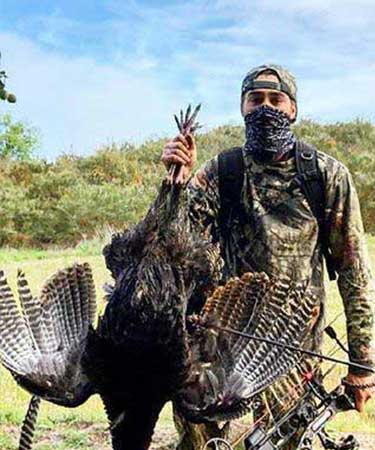
Conservative Game Management presents wild turkey hunting California as a unique set of challenges for hunters. From understanding the diverse turkey species in the state to dealing with unpredictable weather conditions, hunters must be well-prepared to ensure a successful hunt. In this article, we’ll explore the top challenges of California turkey hunting and provide tips on how to overcome them.
Hunting wild turkeys in California requires a deep understanding of their habitats. The state’s diverse topography and climate zones provide various environments conducive to different turkey species. Here’s a detailed look into the methods to pinpoint these habitats:
California is home to several turkey species, each with its distinct habitat preference:
Rio Grande Turkey: These turkeys are often found in arid regions of California. They prefer lower elevations with sparse vegetation, such as grasslands and open woodlands. Their lighter coloration and buff or light brown tail feathers make them distinguishable. They are known for their adaptability and can thrive in various habitats. In California, these turkeys predominantly reside in the Central Valley and foothills1.
Merriam’s Turkey: Thriving in forested regions and mountainous terrains, Merriam’s Turkeys are more likely to be found in higher elevations or coniferous forests. Their white-tipped tails and vibrant colors set them apart. They are adept at navigating mountainous environments and often roost in trees at higher altitudes. Key regions for these turkeys include northern and eastern California, especially the Sierra Nevada region1.
Topographical maps provide detailed information about the physical features of an area. These maps can help hunters identify potential roosting spots for California turkey hunting, feeding areas, and water sources. Elevations, valleys, and forested regions can be easily pinpointed, aiding in the location of preferred turkey habitats.
Local hunters, wildlife experts, and communities often possess invaluable knowledge about turkey habitats in their regions. Engaging with them can provide insights into turkey movement patterns, preferred feeding grounds, and roosting spots, helping to have the best California turkey hunting experience.
Physical signs can indicate turkey presence in an area. These include:
Tracks: Turkey footprints are distinct, with three forward-pointing toes.
Droppings: The shape and size of droppings can indicate the age and gender of the turkey.
Feathers: Shed feathers can provide clues about the species and their recent presence.
Roosting Spots: Turkeys often roost in trees. Look for large horizontal branches that can support turkeys.
Like trail cameras, modern technology can be strategically placed in potential habitats to monitor turkey activity. These cameras can capture images or videos when motion is detected, providing real-time information about turkey presence and movement patterns.
Successfully pinpointing turkey habitats in California requires a combination of understanding the species, utilizing tools and technology, and leveraging local knowledge. With the right strategies, hunters can increase their chances of locating and successfully hunting turkeys in the diverse landscapes of California.
Weather can be a significant factor when hunting turkeys. For instance, male turkeys are more active during the spring mating season, making them more responsive to calls. However, unpredictable behavior driven by hormones can make California turkey hunting challenging during this period.
Tip: Always check the weather forecast before heading out. Dress in layers to adapt to changing conditions and be prepared with rain gear if necessary.
Safety should always be a priority. Ensure you have the necessary licenses and permits before heading out. In California, both residents and non-residents must purchase a hunting license. Additionally, an Upland Game Bird validation is required to hunt turkeys1.
Tip: Familiarize yourself with local regulations, bag limits, and legal hours for California turkey hunting. Always practice safe gun handling and be aware of other hunters in the area.
Turkeys have keen eyesight, making it essential for hunters to remain concealed. Whether you’re in the Sierra Nevada’s dense forests or the Central Valley’s open grasslands, staying hidden is crucial.
Tip: Use camouflage clothing and gear that matches the environment. Stay still and avoid making unnecessary movements when turkeys are nearby.
Understanding turkey behavior is key to a successful hunt. For instance, male turkeys are more responsive to hen calls during the spring season as they seek out potential mates. In contrast, during the fall season, turkeys focus on feeding, making them more responsive to feeding calls1.
Tip: Adjust your calling strategy based on the season. In spring, use hen calls to attract males; in fall, feed calls like soft clucks and purrs.
California turkey hunting offers a thrilling experience for hunters. Understanding the challenges and equipping yourself with the right knowledge and strategies can increase your chances of a successful hunt. Happy hunting!
Are you looking to embark on the best-guided turkey hunts in California? Whether you’re a seasoned hunter or just starting out, the right guidance can make all the difference. Contact Conservative Game Management for expert advice, tips, and all your hunting needs. Call us now at 805-808-8182. Our team is ready to assist you in making your hunting experience in California exceptional. Don’t miss out on the opportunity to learn from the best in the business!
© Copyright 2023-Present Conservative Game Management. All rights reserved.
Hunting Outfitter Websites by Outdoor Marketers